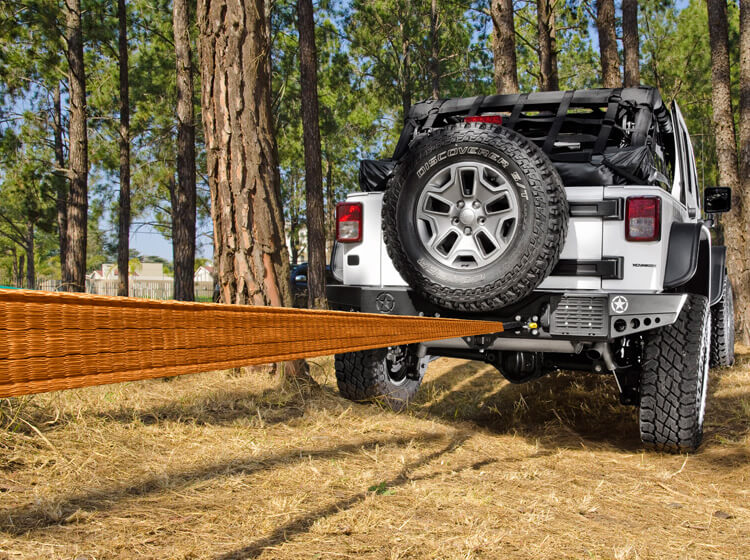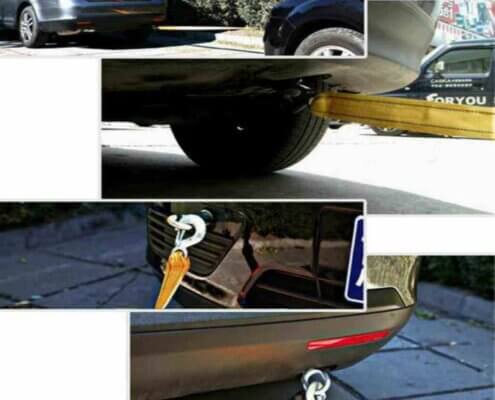4 Most Important Points about Vehicle Tiedown Straps You Need to Know
This is the best instruction book before starting your towing and recovery job on vehicle tiedowns.

You may get a headache when your vehicle gets stuck in the snow, in the mud, in the sand, etc. And how to secure the vehicle out of these bad situations without damaging any rescue vehicles and staff is very important. So, choosing the proper recovery equipment can help you get out of trouble. The same, right tiedowns help you to keep your cargo strongly secured during transportation, no matter a sudden stop, or lane change, the cargo will be safely delivered to the destination.
What’s the Material of Recovery and Tow Strap?
Generally, the vehicle tiedowns are made of polyester webbing and nylon webbing and different application determine using different materials.
If you are working with the towing industry, we recommend our tow ratchet straps to support towing job, because these straps are made of polyester webbing with less stretch and they can hold your cargo firmly. We have multiple options for your choice and you can also customize car straps with your desired end fittings with us.
If you work in the vehicle recovery application, then our nylon straps must be your ideal equipment to rescue the stuck vehicle. We have both 1-ply and 2-ply recovery straps for your choice, they have eyes on both ends to connect with the anchor shackle on the vehicle to start vehicle recovery.
Now, you know what’s the difference between a recovery strap and a tow strap? Of course, the material. Recovery straps are made of nylon webbing and tow straps are made of polyester webbing. These two materials have different abilities for stretch, polyester webbing has less stretch than nylon webbing.
You can not use a recovery strap instead of a tow strap. In the same way, also can not use a tow strap instead of a recovery strap.
The recovery strap is like what you read from the word “recovery” which means this strap is used to rescue the stuck vehicle from a tough situation. You can imagine that the recovery tie down has loops on both ends and when the rescue vehicle starts to move forward to pull the stuck vehicle out of the mud, we need the strap to have more stretch, if we use the tow strap made in polyester webbing, the tie down strap will be very easy to break down.
How do I Find Proper Tiedown Strap to Secure My Vehicle?
First, you should know the weight of your vehicle, you can find the vehicle weight from the car manual or the vehicle body.
Second, after knowing the weight of the vehicle, you need to know clearly the working load limit and breaking strength of the tiedown in your hand. The WLL of the tiedown must match or exceed the weight of your vehicle.
If you would like to know more about the working load limit and breaking strength of tiedowns, you may read: what’s the meaning of working load limit, breaking strength and safety factor?
Widely Used Tiedowns for Recovery Application
Our 1-ply and 2-ply recovery straps are the most commonly used tiedowns for recovery operation.
1-Ply Recovery Straps
We always recommend having one or a few recovery straps on your vehicle to help you with some unexpected situations. Our single-layer recovery straps are made of high-quality nylon webbing and it is very useful when your vehicle gets stuck and can help to pull your car out of a bad situation.
2-Ply Recovery Straps
Two layers recovery strap is stronger than a one-layer recovery strap and it is also made from high-quality nylon webbing. Which type of recovery strap suit your vehicle recovery, you can contact our expert for details.
Rescue vehicles out of the mud, snow, sand, or similar dilemma, the recovery strap is one of the best and most convenient ways to help you solve the problem in a short time with the minimum cost.
Here are different types of car tie downs you may also be interested in.

5 Ways to Use a Recovery Tow Strap
- Attach one end of the strap to the back of the tow tractor, be sure to find the point with a strong structure.
- Attach another of the strap to the front of the vehicle that gets in trouble and we also suggest you find a strong spot or you may read the vehicle manual.
- Ensure both hooks on each car are strongly secured and the drivers can sit in the car. The driver in the rescue car starts to step on the gas slowly to let the strap be its full extent.
- The driver in the stuck vehicle should be in ready, once the front car is moving, you can step on the gas gently and drive the car out of the pit.
- The front recovery car can drive slowly to the nearby rescue site.
Useful Tips for Using Tow Recovery Straps:
- Before every use, check if any damage on your car hauler straps. If you are a beginner, stop your vehicle to check the tie down situation every 30-40 miles.
- If using the towing strap, thread one end of the strap through the eye of another end to choke the proper frame.
- For recovery use, attach your recovery strap to the hardware on the recovery vehicle.
- Check the surrounding, and if anything would damage the tiedowns. If yes, remove them.
- We always recommend our customers choose the breaking strength of the recovery strap that is double of the vehicle weight.
- The stretch of the recovery strap is very important for pulling the vehicle out of the pit, but don’t choose the too strong strap that won’t stretch.
At Webslingness, we have different types of tow and recovery straps, such as heavy tow straps, truck tow straps, off-road recovery straps, etc. If you want to wholesale vehicle tiedown straps, or buy tiedown straps for your own company use, or even need custom straps, Call/WhatsApp us at (0086) 1505 1705 238 or send us an email to: info@webslingness.com


